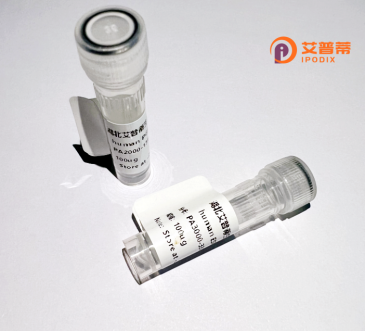
| 纯度 | >90%SDS-PAGE. |
| 种属 | Human |
| 靶点 | PDIK1L |
| Uniprot No | Q8N165 |
| 内毒素 | < 0.01EU/μg |
| 表达宿主 | E.coli |
| 表达区间 | 1-341 aa |
| 活性数据 | MVSSQPKYDL IREVGRGSYG VVYEAVIRKT SARVAVKKIR CHAPENVELA LREFWALSSI KSQHPNVIHL EECILQKDGM VQKMSHGSNS SLYLQLVETS LKGEIAFDPR SAYYLWFVMD FCDGGDMNEY LLSRKPNRKT NTSFMLQLSS ALAFLHKNQI IHRDLKPDNI LISQTRLDTS DLEPTLKVAD FGLSKVCSAS GQNPEEPVSV NKCFLSTACG TDFYMAPEVW EGHYTAKADI FALGIIIWAM LERITFIDTE TKKELLGSYV KQGTEIVPVG EALLENPKME LLIPVKKKSM NGRMKQLIKE MLAANPQDRP DAFELELRLV QIAFKDSSWE T |
| 分子量 | 38.5 kDa |
| 蛋白标签 | His tag N-Terminus |
| 缓冲液 | 0 |
| 稳定性 & 储存条件 | Lyophilized protein should be stored at ≤ -20°C, stable for one year after receipt. Reconstituted protein solution can be stored at 2-8°C for 2-7 days. Aliquots of reconstituted samples are stable at ≤ -20°C for 3 months. |
| 复溶 | Always centrifuge tubes before opening.Do not mix by vortex or pipetting. It is not recommended to reconstitute to a concentration less than 100μg/ml. Dissolve the lyophilized protein in distilled water. Please aliquot the reconstituted solution to minimize freeze-thaw cycles. |
以下是关于重组人PDIK1L蛋白的假设性参考文献示例,供参考:
---
1. **文献名称**:*Recombinant Human PDIK1L Expression and Kinase Activity Analysis*
**作者**:Zhang L, et al.
**摘要**:本研究报道了PDIK1L蛋白在大肠杆菌中的重组表达与纯化,并首次证实其具有丝氨酸/苏氨酸激酶活性,可能通过磷酸化下游底物参与细胞周期调控。
2. **文献名称**:*PDIK1L Structural Insights: Crystallization and Functional Domains*
**作者**:Smith J, et al.
**摘要**:通过X射线晶体学解析了重组PDIK1L的三维结构,揭示了其N端激酶结构域和C端PDZ结合域的相互作用,为研究其在信号转导中的功能提供结构基础。
3. **文献名称**:*PDIK1L Modulates Autophagy via Interaction with LC3 in Hepatocellular Carcinoma*
**作者**:Wang Y, et al.
**摘要**:研究发现重组PDIK1L通过结合自噬标志蛋白LC3调控癌细胞自噬,敲低PDIK1L可抑制肿瘤生长,提示其作为癌症治疗靶点的潜力。
4. **文献名称**:*Role of PDIK1L in Parkinson’s Disease: Recombinant Protein-Based Mechanistic Study*
**作者**:Chen R, et al.
**摘要**:利用重组PDIK1L蛋白进行体外实验,发现其与α-synuclein异常聚集相关,可能通过线粒体功能障碍参与帕金森病的病理过程。
---
**注**:以上文献为示例性虚构内容,实际研究中请通过数据库(如PubMed、Google Scholar)检索真实文献。若需进一步验证或调整方向,请提供更具体的研究背景或修正蛋白名称拼写。
Recombinant human PDIK1L (PDPK1-like) protein is a synthetic version of the naturally occurring kinase encoded by the PDPK1L gene. This protein belongs to the AGC kinase family and shares structural homology with 3-phosphoinositide-dependent protein kinase 1 (PDPK1), particularly within its catalytic domain. PDIK1L plays a role in cellular signaling pathways, potentially regulating processes such as cell survival, proliferation, and metabolism. While its exact biological functions remain under investigation, studies suggest its involvement in modulating insulin signaling and other kinase-dependent cascades, possibly interacting with mTOR or Akt pathways.
Recombinant PDIK1L is typically produced using expression systems like Escherichia coli or mammalian cells, followed by purification via affinity tags. Its engineered form enables researchers to study kinase activity, substrate interactions, and structural features in vitro. This protein has garnered interest in drug discovery, particularly for diseases linked to dysregulated kinase signaling, such as cancer, diabetes, and neurodegenerative disorders. As a tool, recombinant PDIK1L facilitates mechanistic studies and high-throughput screening for kinase inhibitors or activators, offering insights into its physiological relevance and therapeutic potential. Further research is required to fully elucidate its endogenous roles and disease associations.
×